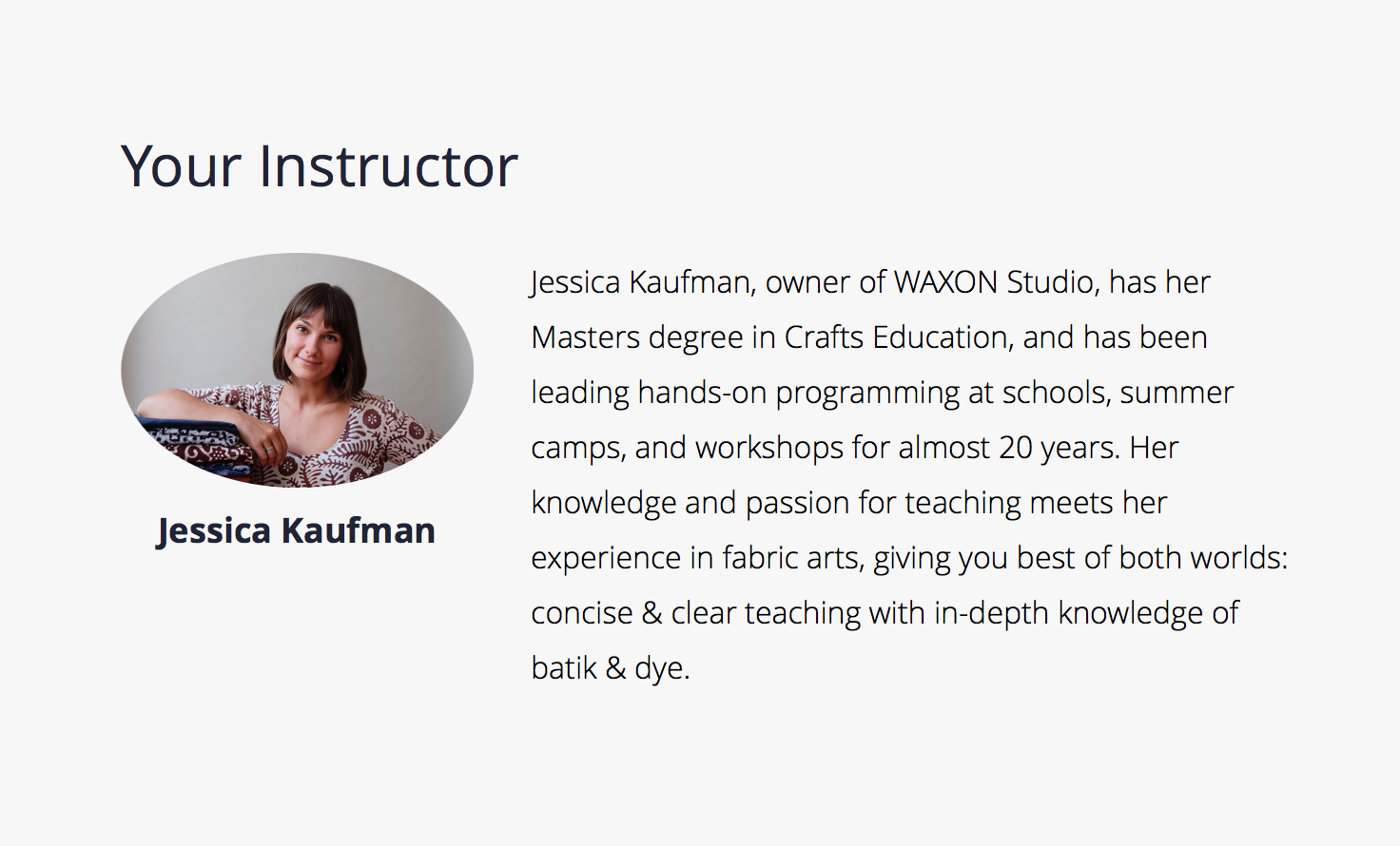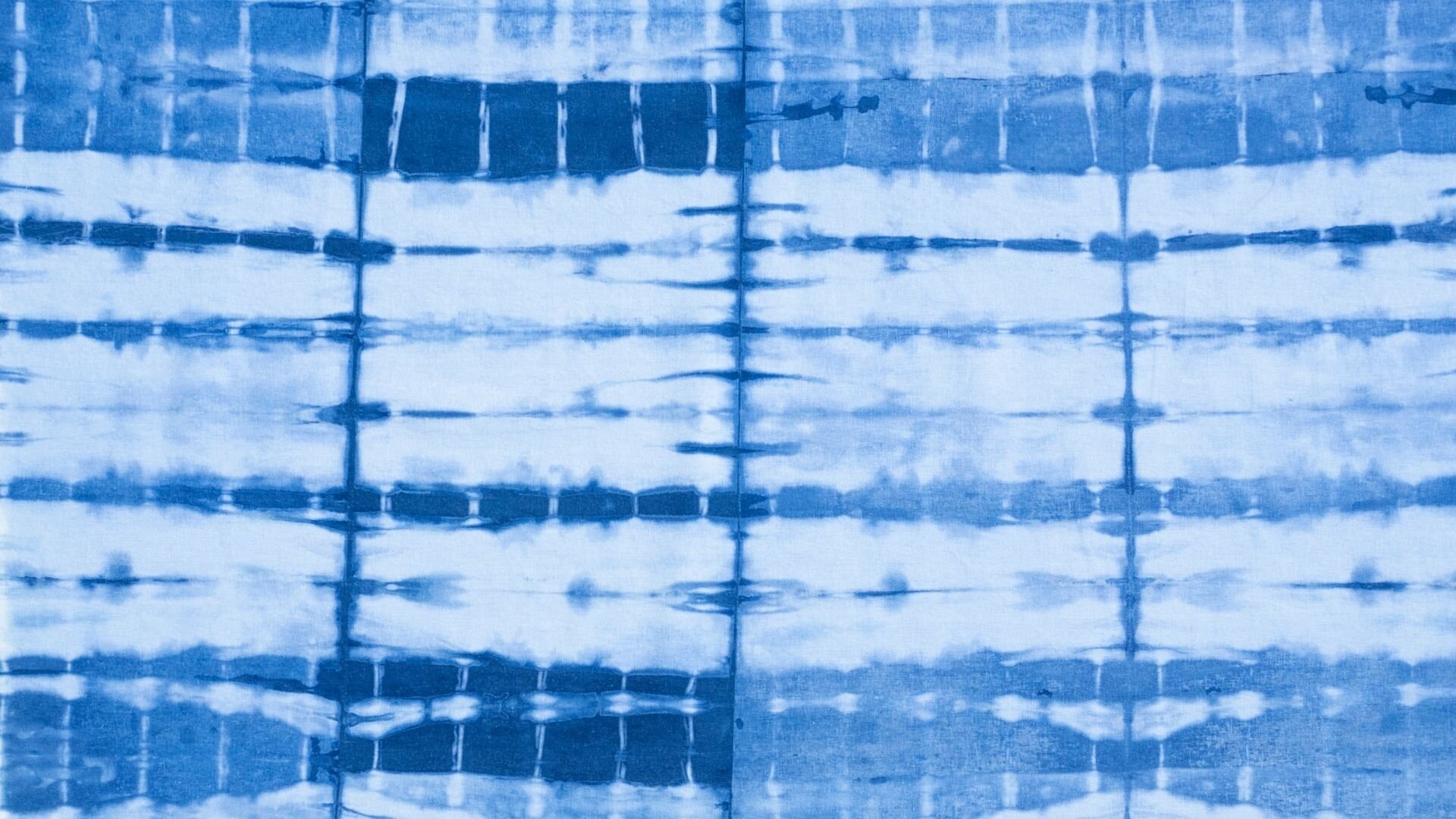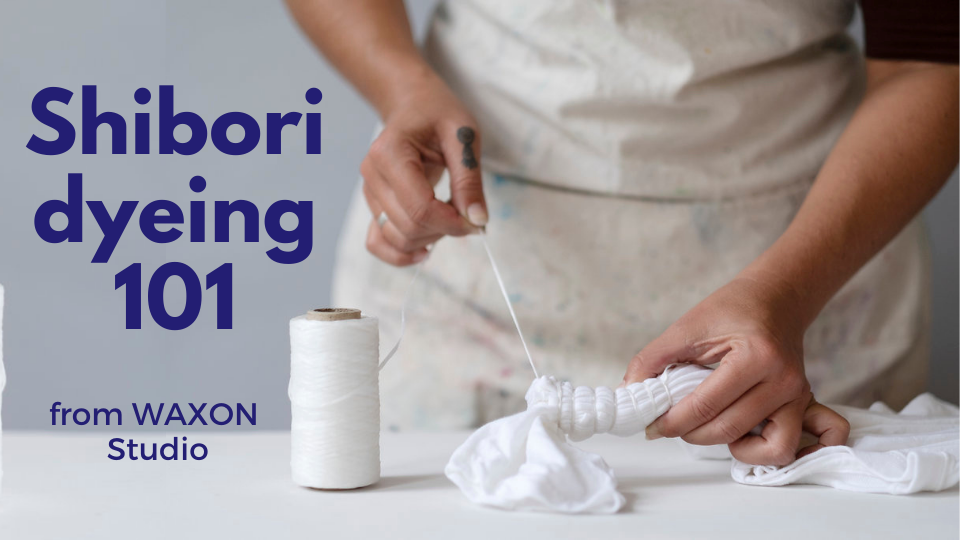The Best Online Textile Dyeing Courses & Classes
Have you ever worked really, really hard at something that you fully believed in the value of doing? Of course you have! Putting in tons of effort to produce something you love is a natural human instinct and an experience most of us pursue at some point in our lives.
As a textile dyeing teacher with years and years of experience, I felt the urge several years ago to compile all my knowledge and information into an online forum where students from all over the world could virtually step into my workshop. It took me so long to finally do it, though.
Sure, running a small business is incredibly time consuming, and it was hard to find the time to even begin listing all the things I’d need to do in order to film, edit, write, and compile photos for everything I wanted my online textile dyeing courses to include.
Finally, the gift of COVID intervened and flipped everything upside down. Instead of spending my Fall of 2020 at a different craft show and festival every weekend, I instead spent it creating my vision: WAXON Studio’s Online Dye Course Catalogue.
What Is Natural Textile Dyeing?
There are many, many different ways you can apply color to fabric. Different cultures all over the world since the very beginning of humanity have developed their own ways of dyeing cloth.
Many of those methods are available to us at home today! There are all kinds of dyes you can use and infinite techniques to be explored. And, there are a few key points to know when considering trying out dyeing at home.
Different Fibers Take Different Types of Dyes
Do you primarily want to dye on rayon? Silk? Cotton? Polyester? Rayon? A blend? Do you know how the fibers were prepared?
What kinds of dyes should you buy? Each different type of fiber has rules about what you can use to dye it and what won’t work very well (if at all).
Different Types of Dyes Use Specific Fixatives or Mordants
Acid dyes (for protein fibers like wool and silk) use something acidic, like vinegar or citric acid, to set the colors. While, fiber reactive dyes (for cellulose fibers like cotton and linen) use basic fixatives, like soda ash.
Plant dyes (like onion skins, persimmon, and madder) use mordants such as alum, iron, tannin, and many more. It’s important to know what other chemicals you’ll need in order to make your dye colors permanent once they’re applied.
“Natural Dyes” Usually Means “Plant Dyes” But Not Always
Just like in any industry, there is a lot of marketing built in to how we talk about the dyes we are using. Phrases like “herbal dyes” come and go in popularity.
Not all natural dyes use natural mordants, and some synthetic dyes are quite low-impact and not very high on the toxicity scale. Some people who wander into our shop want to know if we use plant dyes.
I ask them if they mean dyes that come from plants, or dyes that are meant for plant fibers. It’s important to educate yourself as much as possible when investigating different types of dyes that you might want to use.
There are pros and cons to all of them.
Itajime Shibori on cotton muslin
Indigo dyed, tied with artificial sinew
Why Should I Take a Textile Dyeing Course?
Simply put, for direct, fast, and proven quality! In my textile dyeing courses you're given all the insider info that I've collected over the years through formal & informal study, both in the USA and abroad.
You get all the trial and error, and years spent establishing and growing a successful dye biz. Plus, teaching hundreds and hundreds of kids, teens, and adults how to create their own hand dyed projects over the last 18 years.
In the five years that my small biz, WAXON Studio, has existed, my staff and I have continued spreading the love of dyeing by teaching private & group classes, hosting our DIY tie-dye booth at events large & small, connecting with other dye artists in our region and across the globe, and furthering our own education through our home practices.
We live, breathe, and sleep dyeing techniques! And, we put so much of our knowledge into the textile dyeing courses, we are positive you’re going to love what you learn.
Who Takes an Online Dyeing Class? Are These Designed for Me?
Beginners AND returners. Whether you're beginning to explore home dyeing techniques, or you used to do it back in the day, if your goal is to have a wonderful experience as a hobby dyer working from a home studio, this course will get you proficient, confident, and cruising.
Budding professionals ready to build their empire. Let’s say you want to launch a tie dye business of your own, or lead a summer camp program, maybe run community outreach activities, or be in charge of all the hand-dyeing fundraisers at your campus or workplace- and be in control of your costs and earnings, then this is for you.
Textile lovers of all kinds. You’re ready to explore a sew side of your creativity. Maybe you're the curious artistic soul who has never met a craft he wouldn't try. Or, you've been to Japan and collected all the Shibori you could hold. Or, a sewer who cannot WAIT to dye your own yardage! I've taught all of you before and I'm so psyched to be able to reach you this way, online.
A sampling of different dye techniques, all made at WAXON Studio in Asheville.
What Makes These Online Textile Dyeing Courses a Great Deal?
There are so many exciting, helpful features inherent in the courses that I’ve built! Here are a few of the most important points to consider when enrolling in an online textile dyeing course.
1. One Course, Unlimited Projects
Unlike the in-person classes that I lead at my Asheville workshop, I’m not just taking you through one project. I’m empowering you to come back to the course over and over again, to try new combinations, patterns, and techniques for an endless variety of projects.
2. Filmed Beautifully & Clearly
I used a professional dual-camera set up with an overhead view of my hands and work station. You can enjoy the audio clarity of the body mic I wore while filming, and a beautiful lighting rig that makes all the right visual details pop.
This is NOT a cell-phone video course. Pause and zoom in on any detail you need.
3. Ask Questions, Share Your Photos, Get Feedback
I love that you can ask a question or leave a comment or photo on literally any section in any part of the course. Not only will you get a public response or answer from the instructor (me, Jess), you can also crowdsource and get answers from others in the course.
Everyone who has enrolled can also chime in. As the course ages, and more people learn, our community gets stronger.
4. Sources That Save You Money and Time
Curated insider’s link lists with all my tried & true go-to sources for dyes, tools, materials, blanks, online resources, and more. It took me years to narrow down what works, what's worth buying, and what isn’t.
You get all that info immediately and forever. We'll be updating links when better sources become available or if a favorite is no longer purchasable.
5. Access Your Course From Any Device
When you take an online textile dyeing course from WAXON Studio, you own the course for life. All content is streaming, stored online.
There are no big files on your computer to worry about, and you can connect to any part of the course from any of your devices-- phone, tablet, laptop, any time.
Certain parts of the course are available for download if you should want that option, too. We've created handouts and cheat sheets for you to use at home, and those are printable.
6. Intersects All Learning Styles
Multimedia content (infographics, photos, videos, written step-by-steps, etc.) makes interdisciplinary learning easy to achieve. I don’t want to just be a talking head video endlessly droning on and on, so video portions are sectioned out.
Sections and lectures are easy to find, organized, and thoughtfully arranged so that you can find & review exactly the content you need.
7. A Course That Grows With You
Our courses have updating functionality, which means as we update and add to lists and galleries, your content updates too. When my studio creates content that would be applicable to this course, we'll add it in- free of charge.
Your course materials are always the latest version, because it’s all stored in the cloud, and you automatically access the most recent iteration. Sign up once, and get an ever-evolving product.
It’s awesome, and it means something to me to be able to offer quality content on a really powerful platform.
I know there’s a lot of free content out there. Including mine!
Whatever it is, whatever you’re looking for, remember that your time is valuable.
But wait… these courses cost money! What about just watching free dyeing tutorials on YouTube?
Yes, you can definitely spend hours on YouTube trying to find the answers to your specific questions, trying to problem-solve or get advice, leaving questions in the comments and hoping the artists answer… we’ve all done it.
All the info you want (and don't want) is out there, somewhere, on the internet. And that’s not a bad thing.
I love making free dyeing tutorials for YouTube! It’s nice to be able to share some quick content with people for free.
However, by saving yourself money, you can end up costing yourself time. Not to mention advice that might not work for you, or materials you don't enjoy or can’t find.
There’s no follow up with the instructor. You can get conflicting information, and leave just as confused as you were before, but with more worry and less time!
In creating these courses, I wanted to be able to take you through my entire process, branch out into important subject areas, focus in on key struggle points, give you multidisciplinary learning support, and just be with you from start to finish with the consistency and reassurance that comes from learning 1:1.
My textile dyeing courses aren’t a substitute for searching info online- they’re a solution.
Do I Have to Join an Online Dyeing Course Community or Group?
Something that's important to me: my online textile dyeing courses do not come with access to a private Facebook group “community” (like so many other courses do). And that's on purpose.
Those groups can be great, but do you really want to be in another one? I'll be honest and say I want to divest from Facebook as much as I can, and not make my students spend any more time on there than they already need to.
Our community is built into the features of the course’s platform, no extra steps or sites necessary. In every part of every section of my courses, I've turned the comments feature on.
It works like Facebook, in that we have organized threads with replying and photo-sharing capabilities. I love that our capacity for community exists within the course itself, with helpful threads on each section & lecture, keeping you organized and able to find exactly what you're looking for.
Imagine being able to ask your questions, get answers from me and from others, and even answer other students’ questions in your own words (if you want to). Share photos of successes and struggles, and we'll cheer each other on.
It's a sweet feature, and the more people who participate, the better it gets.
Let’s talk about freebies!
WAXON has plenty of resources that you can sample for zero, zilch, nothin’!
Free Online Textile Dyeing Resources
What if you really can’t commit to spending any money at all right now on instruction? I get it; I’ve been there!
I’ve been putting slices of my knowledge into some cool free resources which I’ll list here for easy access.
Fiber Reactive Dyeing Mini Classes
My mailing list, the Dyenasty, gets a free dyeing tutorial every month or so. If you sign up (and I won’t spam you or sell your info, I promise), you get instant access to mini classes like Low Water Immersion Dyeing, How To Use a Lightbox to Batik, and an hour-long online class called Fiber Reactive Dyes 3 Ways.
Free Batik Course
I have a freebie Batik course available now too! It’s called Two-Layer Batiks, and it’s designed to help you fully understand multilayer batik dyeing and all the steps involved in doing that.
Check it out, it’s absolutely free and it helps you preview my teaching style and my online course catalogue!
Six Steps To Better Tie-Dye
The fastest, handiest thing to have? A downloadable .pdf handout. I designed this little freebie (it’s six pages!) to help total newbies and frustrated amateurs understand the dyer’s workflow.
Grab your digital copy of Six Steps to Better Tie-Dye now!
What Kinds of Online Textile Dyeing Courses Do I Offer?
Okay, so you’re maybe willing to invest in some professional guidance on a bigger scale— you want the compendium of videos, galleries, written step-by-step instructions, and access to the other folks who are also in the class.
But first let’s talk about which courses I have ready for enrollment right now.
Shibori Dyeing 101
Shibori is a beautiful, straightforward method of creating resist patterns on cloth by wrapping, binding, folding, or tying cloth before immersing your piece into a vat of color. Chinese in origin, made famous in Japan, this is our most affordable of the three courses we launched in 2020.
Tie-Dye Basics
For the boho hippie in all of us! There are so many many ways of doing tie-dye, aka bottle dyeing or direct application dyeing.
I get into it with you about patterns, mixing dyes, how to achieve lots of different looks, the best methods for curing and washing, and how to forge your own path while mastering your work flow.
Intro To Ice Dye
Ice dye is beyond magical. Our heftiest class, it offers the most bang for your buck.
You’ll become proficient in ice dyeing on the rack, in the muck, ice over powder or powder over ice, learn patterns from beginning to advanced, and get a comprehensive library of color splits and how to combine them. Our most popular class by enrollment!
If you are looking to up your textile dyeing game, then one of the online textile dyeing courses described above are probably just what you are looking for!
I know, on a personal level, what it means to take on a small hand-dyed biz that actually earns income. And, I would never try to sell you anything that I thought wasn’t going to help you turn around and make money from dyeing, if that’s what you want to do.
Our online textile dyeing courses will add a colorful and enlivening boost to your creative life. I can’t wait to see what you make!
Got questions about any of our courses? Leave a comment below or contact me today.








